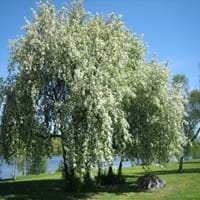Life Span
Perennial
Perennial
Type
Bulb or Corm or Tuber
Tree
Origin
South America, Argentina
Europe, Russia/Siberia, Asia, Central Asia, China, Japan, Korea
Types
Not Available
Alabama Cherry, Wild Cherry, Greyleaf Cherry
Number of Varieties
Not Available
Habitat
Temperate Regions
Woodland Garden Canopy
USDA Hardiness Zone
5-9
3-8
Sunset Zone
21,22
A1, A2, A3, 1a, 1b, 2a, 2b, 3a, 3b, 4, 5, 6, 7, 10
Habit
Clump-Forming
Oval or Rounded
Flower Color
Light Blue, Light Purple, Silver, Sky Blue
White
Flower Color Modifier
Bicolor
Bicolor
Fruit Color
Not Available
Purple, Black
Leaf Color in Spring
Green, Light Green, Gray Green
Light Green
Leaf Color in Summer
Light Green
Green
Leaf Color in Fall
Several shades of Green
Green
Leaf Color in Winter
Light Green
Not Available
Leaf Shape
Grass like
Ovate
Plant Season
Spring
Spring
Sunlight
Full Sun, Partial Sun, Partial shade
Full Sun, Partial Sun
Type of Soil
Clay, Loam, Sand
Clay, Loam
The pH of Soil
Acidic, Neutral, Alkaline
Acidic, Neutral, Alkaline
Soil Drainage
Well drained
Average
Bloom Time
Early Spring, Spring, Late Winter
Spring
Tolerances
Drought
Not Available
Where to Plant?
Container, Ground
Ground
How to Plant?
By dividing rhizomes, tubers
Seedlings, Stem Cutting
Plant Maintenance
Medium
Medium
Watering Requirements
Average Water Needs, Do Not over Water, Requires regular watering
Average Water Needs
In Summer
Lots of watering
Lots of watering
In Spring
Moderate
Moderate
In Winter
Average Water
Average Water
Soil pH
Acidic, Neutral, Alkaline
Acidic, Neutral, Alkaline
Soil Type
Clay, Loam, Sand
Clay, Loam
Soil Drainage Capacity
Well drained
Average
Sun Exposure
Full Sun, Partial Sun, Partial shade
Full Sun, Partial Sun
Pruning
Remove damaged leaves, Remove dead branches, Remove dead leaves
Pruning during middle of summer, Remove damaged leaves, Remove dead branches, Remove dead leaves, Remove dead or diseased plant parts
Fertilizers
All-Purpose Liquid Fertilizer
Apply 10-10-10 amount
Pests and Diseases
Slugs, Snails
Red blotch
Plant Tolerance
Drought
Not Available
Flower Petal Number
Single
Single
Foliage Texture
Medium
Medium
Foliage Sheen
Matte
Matte
Attracts
Bees, Birds, Hummingbirds
Birds
Allergy
Not Available
Pain and fatigue, Respiratory problems, Toxic
Aesthetic Uses
Showy Purposes
Showy Purposes
Beauty Benefits
Not Available
Not Available
Environmental Uses
Air purification
Air purification, Nesting sites for birds, Shadow Tree, Shelter for wildlife
Medicinal Uses
No Medicinal Use
Anodyne, Diuretic, Febrifuge, Sedative
Part of Plant Used
Flowers
Bark, Flowers, Fruits, Leaves, Seeds, Wood
Other Uses
Not Available
Used for making dark grey to green dye, Wood is used for cabinet makers
Used As Indoor Plant
Yes
No
Used As Outdoor Plant
Yes
Yes
Garden Design
Container, Lawns and Turf, Mixed Border, Rock Garden / Wall, Wildflower
Screening / Wind Break
Botanical Name
Ipheion uniflorum
PRUNUS padus
Common Name
Spring Starflower, Springstar
Bird Cherry
In Hindi
Spring Starflower
सुंदार वृक्ष
In German
Frühling Borretsch
Vogel Kirschbaum
In French
Spring Starflower
Oiseau Cherry Tree
In Spanish
primavera Flor de estrella
Pájaro Cerezo
In Greek
άνοιξη starflower
Bird Cherry Tree
In Portuguese
primavera Starflower
Árvore de cereja do pássaro
In Polish
Wiosna Starflower
Czeremcha drzewa
In Latin
Spring Starflower
Ave Ave ligno
Phylum
Magnoliophyta
Magnoliophyta
Class
Lilopsida
Magnoliopsida
Order
Asparagales
Rosales
Family
Liliaceae
Rosaceae
Clade
Angiosperms, Monocots
Angiosperms, Eudicots, Rosids
Tribe
Gilliesieae
Acacieae
Subfamily
Allioideae
Prunoideae
Number of Species
Not Available
Season and Care of Spring Starflower and Bird Cherry
Season and care of Spring Starflower and Bird Cherry is important to know. While considering everything about Spring Starflower and Bird Cherry Care, growing season is an essential factor. Spring Starflower season is Spring and Bird Cherry season is Spring. The type of soil for Spring Starflower is Clay, Loam, Sand and for Bird Cherry is Clay, Loam while the PH of soil for Spring Starflower is Acidic, Neutral, Alkaline and for Bird Cherry is Acidic, Neutral, Alkaline.
Spring Starflower and Bird Cherry Physical Information
Spring Starflower and Bird Cherry physical information is very important for comparison. Spring Starflower height is 10.20 cm and width 5.10 cm whereas Bird Cherry height is 1,500.00 cm and width 600.00 cm. The color specification of Spring Starflower and Bird Cherry are as follows:
Spring Starflower flower color: Light Blue, Light Purple, Silver and Sky Blue
Spring Starflower leaf color: Green, Light Green and Gray Green
Bird Cherry flower color: White
- Bird Cherry leaf color: Light Green
Care of Spring Starflower and Bird Cherry
Care of Spring Starflower and Bird Cherry include pruning, fertilizers, watering etc. Spring Starflower pruning is done Remove damaged leaves, Remove dead branches and Remove dead leaves and Bird Cherry pruning is done Pruning during middle of summer, Remove damaged leaves, Remove dead branches, Remove dead leaves and Remove dead or diseased plant parts. In summer Spring Starflower needs Lots of watering and in winter, it needs Average Water. Whereas, in summer Bird Cherry needs Lots of watering and in winter, it needs Average Water.





